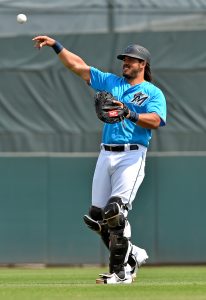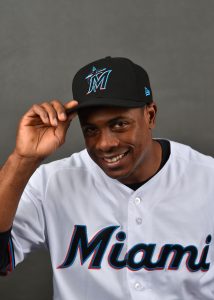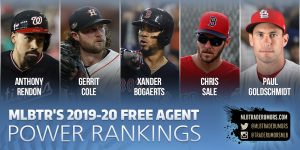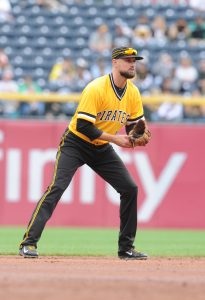The following 40-man roster players have less than five years service time and are out of minor league options. That means they must clear waivers before being sent to the minors. I’ve included players on multiyear deals. This list was compiled through MLBTR’s helpful sources.
Angels
- Cam Bedrosian, RHP
- Kaleb Cowart, 2B/3B/RHP
- Luis Garcia, RHP
- Noe Ramirez, RHP
- Hansel Robles, RHP
- Kevan Smith, C
Astros
- Aledmys Diaz, INF/OF
- Tony Kemp, 2B/OF
- Brad Peacock, RHP
- Max Stassi, C
- Tyler White, 1B/3B/DH
Athletics
- Aaron Brooks, RHP
- Robbie Grossman, OF
- Liam Hendriks, RHP
- Chris Herrmann, C/OF
- Frankie Montas, RHP
- Josh Phegley, C
- Jurickson Profar, SS/2B/3B
Blue Jays
- Randal Grichuk, OF
- Dalton Pompey, OF
Braves
- Jesse Biddle, LHP
- Charlie Culberson, 2B/SS/3B/OF
- Sam Freeman, LHP
- Kevin Gausman, RHP
- Luke Jackson, RHP
Brewers
- Jesus Aguilar, 1B
- Junior Guerra, RHP
- Corey Knebel, RHP
- Erik Kratz, C
- Hernan Perez, 2B/3B/OF
- Manny Pina, C
- Eric Thames, 1B/OF
Cardinals
- John Gant, RHP
- Mike Mayers, RHP
- Miles Mikolas, RHP
- Chasen Shreve, LHP
Cubs
- Mike Montgomery, LHP
Diamondbacks
- Silvino Bracho, RHP
- Socrates Brito, OF
- Zack Godley, RHP
- Matt Koch, RHP
- T.J. McFarland, LHP
- John Ryan Murphy, C
- Christian Walker, 1B/OF
Dodgers
- Yimi Garcia, RHP
Giants
- Hanser Alberto, 2B/3B/SS
- Sam Dyson, RHP
- Trevor Gott, RHP
- Alen Hanson, 2B/OF
- Steven Okert, LHP
- Chris Stratton, RHP
- Mac Williamson, OF
Indians
- Trevor Bauer, RHP
- Max Moroff, 2B/3B/SS
- Tyler Olson, LHP
- Kevin Plawecki, C
- Neil Ramirez, RHP
- Danny Salazar, RHP
Mariners
- Shawn Armstrong, RHP
- Roenis Elias, LHP
- Marco Gonzales, LHP
- Kristopher Negron, 2B/OF
- Zac Rosscup, LHP
- Domingo Santana, OF
- Hunter Strickland, RHP
- Sam Tuivailala, RHP
- Daniel Vogelbach, 1B/DH
Marlins
- Jorge Alfaro, C
- Austin Brice, RHP
- Adam Conley, RHP
- Tayron Guerrero, LHP
- Rosell Herrera, 2B/OF
- Dan Straily, RHP
- Jose Urena, RHP
Mets
- Keon Broxton, OF
Nationals
- Matt Grace, LHP
- Justin Miller, RHP
- Pedro Severino, C
Orioles
- Dylan Bundy, RHP
- Miguel Castro, RHP
- Renato Nunez, 3B
- Jonathan Villar, 2B/SS/3B
- Mike Wright Jr., RHP
Padres
- Greg Garcia, 2B/SS
- Bryan Mitchell, RHP
- Kirby Yates, RHP
Phillies
- Aaron Altherr, OF
- Jose Alvarez, LHP
- Cesar Hernandez, 2B
- Adam Morgan, LHP
- Hector Neris, RHP
- Roman Quinn, OF
Pirates
- Elias Diaz, C
- Erik Gonzalez, SS/2B
- Nick Kingham, RHP
- Jacob Stallings, C
- Felipe Vazquez, LHP
Rangers
- Connor Sadzeck, RHP
Rays
- Ji-Man Choi, 1B/DH
- Wilmer Font, RHP
- Tommy Pham, OF
- Chaz Roe, RHP
Red Sox
- Heath Hembree, RHP
- Brian Johnson, LHP
- Sandy Leon, C
- Blake Swihart, C
- Christian Vazquez, C
- Brandon Workman, RHP
Reds
- Curt Casali, C
- Amir Garrett, LHP
- Robert Stephenson, RHP
- Matt Wisler, RHP
Rockies
- Tom Murphy, C
- Scott Oberg, RHP
- Chris Rusin, LHP
- Raimel Tapia, OF
Royals
- Brian Flynn, LHP
- Brian Goodwin, OF
- Terrance Gore, OF
- Jorge Lopez, RHP
- Adalberto Mondesi, SS/2B
- Jorge Soler, OF/DH
Tigers
- Matthew Boyd, LHP
- Buck Farmer, RHP
- John Hicks, C/1B
- Mikie Mahtook, OF
- Drew VerHagen, RHP
Twins
- Ehire Adrianza, SS/2B/3B
- Tyler Austin, 1B/DH/OF
- C.J. Cron, 1B
- Max Kepler, OF
- Matt Magill, RHP
- Trevor May, RHP
- Adalberto Mejia, LHP
- Blake Parker, RHP
- Jorge Polanco, SS
- Michael Reed, OF
White Sox
- Manny Banuelos, LHP
- Alex Colome, RHP
- Leury Garcia, OF
- Juan Minaya, RHP
- Jose Rondon, 2B/SS
- Yolmer Sanchez, 2B/3B
Yankees
- Luis Cessa, RHP
- Tommy Kahnle, RHP
- Gary Sanchez, C




 Jordy Mercer and Josh Harrison have spent virtually their entire MLB careers as teammates. That connection will continue for at least part of the 2019 season, as the former Pirates each signed on to form Detroit’s new middle infield duo. The Tigers turned to Mercer to fill the hole left behind by free agent shortstop Jose Iglesias, then later inked Harrison to take over as the everyday second baseman. Such names as
Jordy Mercer and Josh Harrison have spent virtually their entire MLB careers as teammates. That connection will continue for at least part of the 2019 season, as the former Pirates each signed on to form Detroit’s new middle infield duo. The Tigers turned to Mercer to fill the hole left behind by free agent shortstop Jose Iglesias, then later inked Harrison to take over as the everyday second baseman. Such names as